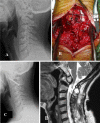Atlantoaxial transarticular screw fixation and posterior fusion using polyester cable: a 10-year experience
- PMID: 23608934
- PMCID: PMC3698352
- DOI: 10.1007/s00586-013-2789-2
Atlantoaxial transarticular screw fixation and posterior fusion using polyester cable: a 10-year experience
Abstract
Purpose: To retrospective review the clinical outcomes of the modified operative technique using a polyester suture material (Ethibond* Excel) for atlantoaxial transarticular screw fixation and posterior fusion.
Methods: The retrospective reviews were conducted from 2002 to 2012. The patient's medical record reviews included demographic data, cause of atlantoaxial instability, orthopedic and surgical history, clinical presentation, radiographic finding including plain radiography, complications, operative detail, and outcome of treatment. Fusion of C1-C2 was defined as either graft consolidation or absence of C1-C2 movement on lateral flexion-extension radiograph.
Results: Twenty-three patients demonstrated clinical and radiographic evidence of atlantoaxial instability (13 men and 10 women, with a mean age of 42 years). Majority of atlantoaxial instability was caused by trauma. Most common clinical symptom was neck pain with or without cervical myelopathy. Bilateral screws were placed in 18 of the 23 patients. Five patients underwent placement of unilateral screws. The 13 patients were inserted by screws with diameter 4.0 mm. The means screw length was 40.33 mm. The means of operative time and estimated blood loss were 3.6 h and 234 ml, respectively. The mean of follow-up duration was 18 months. All 41 screws were positioned satisfactorily in C1 lateral mass. All 23 patients achieved fusion (100% fusion rate). After a period of follow-up, 9 of the 10 neurological deficit patients had completely recovered.
Conclusions: We concluded that the atlantoaxial transarticular screw fixation and posterior fusion using polyester cable can be used for C1-2 fusion with a high fusion rate and less complications in various cases.
Figures


Similar articles
-
[Transarticular fixation of C1-C2: a multicenter retrospective study].Acta Chir Orthop Traumatol Cech. 2004;71(1):6-12. Acta Chir Orthop Traumatol Cech. 2004. PMID: 15069856 Czech.
-
[Harms technique of C1-C2 fixation with polyaxial screws and rods].Acta Chir Orthop Traumatol Cech. 2005;72(1):22-7. Acta Chir Orthop Traumatol Cech. 2005. PMID: 15860148 Czech.
-
Anatomic considerations of anterior transarticular screw fixation for atlantoaxial instability.Spine (Phila Pa 1976). 1998 Jun 1;23(11):1229-35; discussion 1236. doi: 10.1097/00007632-199806010-00011. Spine (Phila Pa 1976). 1998. PMID: 9636976
-
Atlantoaxial fusion with transarticular screws: meta-analysis and review of the literature.World Neurosurg. 2013 Nov;80(5):627-41. doi: 10.1016/j.wneu.2012.03.012. Epub 2012 Mar 31. World Neurosurg. 2013. PMID: 22469527 Review.
-
The Comparison Between Transarticular Screw Fixation and Segmental Screw-Rod Fixation for Posterior Fusion of the C1-2 Segment: A Systematic Review and Meta-Analysis.World Neurosurg. 2022 Aug;164:e1007-e1014. doi: 10.1016/j.wneu.2022.05.086. Epub 2022 May 26. World Neurosurg. 2022. PMID: 35643403
Cited by
-
Characteristics of Screw Perforation and Screw Loosening in Atlantoaxial Transarticular Fixation Using a Preoperative Computed Tomography-Based Navigation System.Int J Spine Surg. 2024 Nov 8;18(5):477-481. doi: 10.14444/8604. Int J Spine Surg. 2024. PMID: 38744483 Free PMC article.
-
Potential intraoperative factors of screw-related complications following posterior transarticular C1-C2 fixation: a systematic review and meta-analysis.Eur Spine J. 2019 Feb;28(2):400-420. doi: 10.1007/s00586-018-5830-7. Epub 2018 Nov 22. Eur Spine J. 2019. PMID: 30467736
-
A prospective, double-blind, randomized controlled trial of treatment of atlantoaxial instability with C1 posterior arches >4 mm by comparing C1 pedicle with lateral mass screws fixation.BMC Musculoskelet Disord. 2016 Apr 14;17:164. doi: 10.1186/s12891-016-1017-8. BMC Musculoskelet Disord. 2016. PMID: 27075577 Free PMC article. Clinical Trial.
-
Outcome Instruments in Spinal Trauma Surgery: A Bibliometric Analysis.Global Spine J. 2016 Dec;6(8):804-811. doi: 10.1055/s-0036-1579745. Epub 2016 Mar 7. Global Spine J. 2016. PMID: 27853666 Free PMC article. Review.
-
A novel method to judge the safe position of C2 lamina screw with double holes.BMC Musculoskelet Disord. 2024 Nov 15;25(1):913. doi: 10.1186/s12891-024-07995-w. BMC Musculoskelet Disord. 2024. PMID: 39548472 Free PMC article.
References
Publication types
MeSH terms
Substances
LinkOut - more resources
Full Text Sources
Other Literature Sources
Miscellaneous

